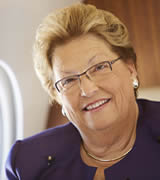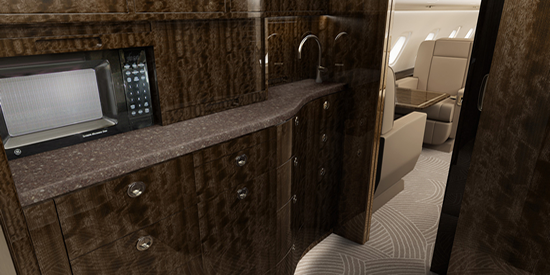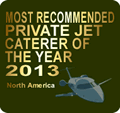| BlueSky Business Aviation News | ||||||||||||||||||||||||||||||||
| . | ||||||||||||||||||||||||||||||||
My parents would buy a side of beef or pig and have the butcher prepare the meat for the family so it was always ready to be pulled out of the freezer for dinner. Back then we pulled the meat out at breakfast time and let it sit in the sink, thawing until dinner. Today I wonder how none of us died from a food related illness . . . or even just got seriously sick! As time has passed and the microwave has become a standard household item, learning to cook with it has been a 'trial and error' journey. Since my family never owned a microwave, I wasn’t able to pick up tricks and great recipes for microwave cooking, but my children and now grandchildren certainly have self-taught themselves in its great uses.
The global aviation community hasn’t had the opportunity for generations of flight crews to teach one another how they have creatively used the microwave in the galley, but we're quickly learning and sharing more each day. So where do you go to learn how to correctly reheat or cook on board when the microwave is your galley’s main piece of cooking equipment? I don’t know of a book of tips and tricks for flight crews dealing with cabin pressure, altitude, and low humidity issues, but why can’t we share our own successes and tips on how to be creative with a microwave? Let me start by sharing the tips I have acquired over the years by working with flight crews. They'll help you when using a microwave to cook or reheat on board, and also provide food safety information and precautions to consider as you do so. Safety First First I want to point out several food safety related items that MUST be considered when microwaving food - whether on the ground, or in the air. If using the microwave to thaw a frozen item, it MUST be cooked immediately. The food cannot be set aside for cooking later because, as the food item defrosts, the outside of the food has already starting cooking - but there could still be cold spots inside the food itself. This is the perfect environment for bacteria (a tidbit of trivia: bacteria doubles every 20 minutes) to multiply, and only by cooking the food to the right temperature internally immediately after thawing, can the bacteria be stopped and destroyed.
Adjust cooking times based on the power of your microwave. Food will take longer to reach a safe internal temperature in a lower-powered microwave. Do not re-use trays and containers that come with microwave dinners or take-outs. These trays and containers are usually designed for one-time use only and may not be safe for microwave use. Food cooks, from the outside in ½ ” to 1” only, so there will be cold spots in the food. Food must be reheated to an internal core temperature of 165°F / 74ºC, so liquid, saucy, soup items will have to be stirred several times to achieve the internal temperature before food is safe to eat. When reheating sauces, soups, or gravies, always bring the liquid to a boil, in a microwave or stove top, to destroy any potential bacteria. The microwave is not the perfect solution to heat Beurre Blanc or Hollandaise sauce as they will break when heated as high as you should for safety. Dense food items, such as stuffed poultry or meats, are especially dangerous to reheat in a microwave. This is because the outside will heat hot enough, but the density of the stuffing inside the poultry or meat will remain cool inside. Since the heat penetration is not likely to occur in a dense food like stuffing, there will not be enough heat penetration to destroy any potential bacteria lurching in the stuffing. When NOT to use a microwave DO NOT reheat food items in a can or other sealed container in the microwave. Even a Ziploc bag in the microwave should be vented. There is a new product on the market that I was shown by Airware that is a food grade bag, that seals and you can cook, or steam food (in the oven, the microwave or on the charcoal grill) without venting the bag. It does not burst in the microwave and will not catch fire on the oven or grill. It is really cool stuff and can potentially save a lot of galley space with the reduction of backup cooking containers. It can be placed in the oven on the shelf without a pan. Oils do not reheat well in a microwave so DO NOT attempt to fry foods in the microwave. Sounds crazy I know, but, I wouldn’t mention it if I had not known of someone trying this. I know this may sound crazy too, but DO NOT attempt to dry clothes or dishtowels in the microwave. Some stains on fabric will heat to a melting point and a fire may erupt. Hot towels passed prior to meal service can be heated in the microwave as long as the container used is microwave safe and only water with no oils are used on the towels. Water might contain a citrus juice or herb infusion however.
For those of you who might have infants on board, heating baby bottles and food is regularly done in the microwave, but be sure to remember that food will have hot spots and cold spots. Shake a heated bottle, let it stand and test before giving it to a child; stir baby food, and allow to sit before giving it to a child. Microwaved food will continue to heat even after it comes out of the unit as the “dancing” molecules continue to move for up to two minutes, and what started out warm, may end up getting hotter as it sits. This is why microwaved rolls heated up to be hot will within a few minutes, turn rock hard. Several years ago, I learned a trick for heating liquids in the microwave that has prevented many steam burns in our catering kitchen. My trivia tidbit for you: Take precautionary action when heating a liquid such as a cup of water, coffee, or tea. Always place a stirrer or microwavable stick in a liquid when heating to prevent the possibility of a boiling liquid explosion. As a liquid heats it creates steam, and as the microwave continues to heat the liquid that steam must escape rather than be held under the surface of the liquid. Did you realize that water can boil in a microwave without bubbling on the surface? The stick or stirrer allows the steam bubbles to escape so that when the liquid is removed from the microwave and you wiggle it, those hidden steam bubbles will not be waiting to escape all over your hand, the galley carpet, countertop or the intended recipient. This is referred to as super-heated water. It is rare, but does occur. Be cautious of reheating or cooking a food with any sort of skin or outer membrane on it. Gently puncture the outer membrane before heating sausages, potatoes, eggs or they may burst in the microwave. There are numerous foil pans on the market that are safe to microwave in, BUT, they must not touch the sides of the microwave interior and MUST be 2/3 full of food to prevent arcing and yes they too will state they are microwave safe. The food industry calls these CPET containers. Separate food items when microwaving because fats, sugars and water all heat differently. Request your microwave food packaging contain only one type food item per container when possible rather than placing an entire meal in one container. Some things will be overcooked while others may still be cold after microwaving. And guess what? B-A-C-T-E-R-I-A will thrive! Place food in the center of the microwave so that the “micro-waves” can “ping” in, through and off the food more evenly. When heating an item, you will get the best results by placing similar size items in a ring shape, like a donut, or if mixing sizes and shapes of food, place the larger items being reheated on the outside of the plate and smaller ones on the inside. In praise of the microwave I suppose I have warned you so much you have decided to quit using the microwave altogether or never start, right? I hope not; let’s talk a little about what a great tool the microwave is (and please share any of your findings with me as well). Asparagus can be cooked to absolute perfection in a microwave, it will remain bright green, perfectly crisp by simply rolling up the spears in a paper towel and microwaving. Wet the paper towels with about ¼ cup water per pound of asparagus, lay spears on the wet towels, roll up, and microwave 3-4 minutes. Let rest a minute and voila! Another great vegetable to prepare in a record amount of time is the artichoke. It may take upwards of 30 minutes to prepare an artichoke the old fashioned way in boiling water which is difficult on an aircraft but in a micrwave it can be done in 5 -8 minutes.
Have someone on board who can’t tolerate the skin of a tomato or peach? The microwave is a simple solution for you to remove the skin of either without making a mess out of the fruit. Fresh salsa on board, here you come! Simply slide the peach or tomato in the microwave for about 30 seconds and allow it to rest a couple of minutes and the skin will slide right off. Super easy . . . Stale crackers or crisps? Simply place them on a paper towel and microwave for a few seconds. If the bag has been left open and they become soggy a simple zap! And the chips are crisp again. This technique does not work for breads and rolls. You need to under heat the rolls and bread products and allow them to “rest” before serving. If you fully heat them, as they “rest” they will become hard as a rock! Also, if your bread is crusty it will become limp and soggy when heated in the microwave. (Best to use these new cooking bags in the oven for crusty bread exteriors when reheating). Do you love the smell of bacon cooking? It signals breakfast, it is a wakeup call. It is one of those smells that we can smell in the aircraft even with all those barriers to our sense of taste and smell that we encounter in aviation. Yum! The nicest thing about microwave bacon is that by using a paper towel, most all the grease we normally have to deal with is absorbed by the paper towel so no grease drips on the aircraft carpet. I just tried bacon in those new baking bags and it was perfect. Once I opened the bag, my clean-up didn’t even get my hands dirty. The bag went straight into the bin and so little trash to dispose of when done. Fresh juice? If you have trouble getting juice from oranges, lemons and limes by squeezing, turn to your trusty microwave. If you've a hard or dry citrus fruit, pop it in the microwave for 20-30 seconds and then it's ready for juicing. Not too much longer though or you will have a cooked fruit juice. I have run on and on again, I love the microwaving food course I teach. It is really so much fun and I learn something new every time I present it. I know we all have other tips for microwaving in the air. I am really anxious to hear what you do on board and how you use your microwave. Anyone have any wacky stories about microwaves? Let me know. I would love to hear from you, and maybe we can create a tips and techniques handbook for flight crews!
Let me introduce myself . . . My name is Paula Kraft and I am founder and President of Tastefully Yours Catering, an aviation specific caterer, located in Atlanta, Georgia for over 35 years.
Currently I am an active member of the NBAA Flight Attendant Committee Advisory Board and the NBAA International Flight Attendant Committee, Women in Corporate Aviation, Women in Aviation International, National Association of Catering Executives, International Flight Catering Association, the International Food Service Association and the International Caterer’s Association. I have coordinated training programs and clinics for NBAA and EBAA conference attendees for over 10 years, created mentoring programs for caterers and flight attendants to broaden their aviation culinary skills, and to assist them in adapting to the unique challenges and constraints found in catering for general aviation. I recognize the need for training and have worked closely with flight departments, flight crews, schedulers and customer service reps at the FBOs to ensure that catering specific training provides information and skills necessary to reduce risk while assisting them in their job duties that include safe food handling, catering security, accurate transmission of food orders, and safe food production, packaging and delivery. I fell into aviation catering quite by accident. I was the in-house caterer and bakery supplier for Macy’s department stores in Atlanta when catering was ordered for a Macy’s customer which was soon to change my life. After the client enjoyed the catering provided, I was summoned to the client’s corporate office to provide several of the items delivered through Macy’s to the executive dining room. Within a week, I was providing food for the flight department and my first order was for the President of a foreign country (as I was too be told soon after). So, here I am, some 35 years later, still loving every minute of every day in aviation catering.
|
||||||||||||||||||||||||||||||||








